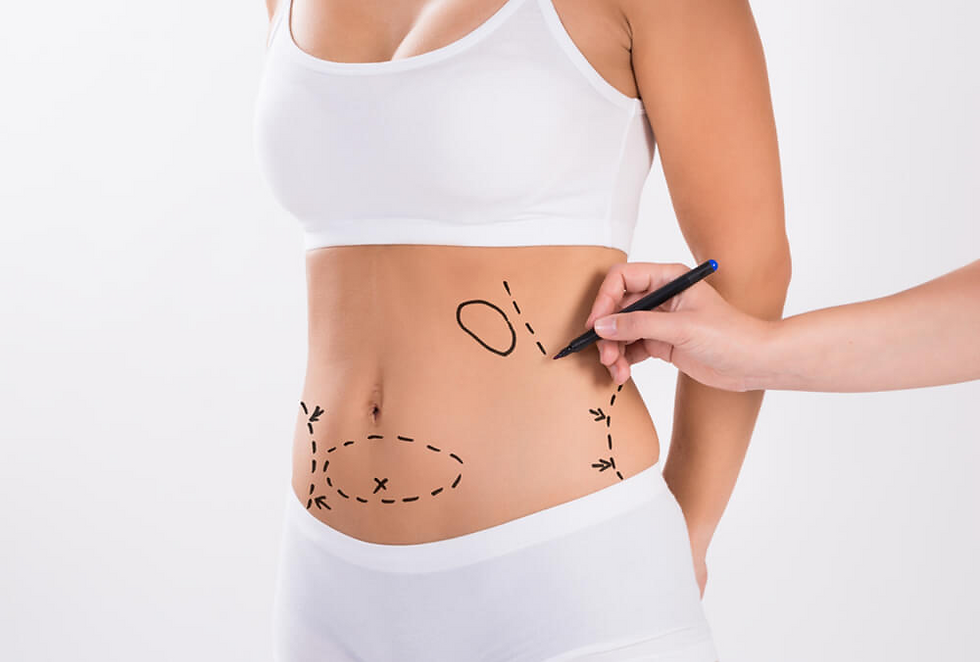Comparing Laser Liposuction and Traditional Liposuction: Which is Right for You?
- umershafqatt
- Sep 14, 2024
- 4 min read
When considering body contouring options, laser liposuction and traditional liposuction are two popular methods. Both procedures aim to remove excess fat and improve body shape, but they differ significantly in techniques, recovery times, and outcomes. Understanding the key differences between these two approaches can help you make an informed decision about which is best for your needs and goals. This article provides a comprehensive comparison of Laser Liposuction in Dubai and traditional liposuction.
Laser Liposuction vs. Traditional Liposuction: An Overview
1. Laser Liposuction
Laser liposuction, also known as laser-assisted liposuction (LAL), uses laser energy to liquefy fat cells before they are removed from the body. The procedure is minimally invasive and typically involves smaller incisions compared to traditional liposuction.
Technology: Uses laser energy to target and melt fat cells.
Procedure: Fat is liquefied with a laser and then suctioned out using a cannula.
Recovery: Generally quicker recovery with less swelling and bruising.
Benefits: Often results in tighter skin due to the laser’s collagen-stimulating effects.
2. Traditional Liposuction
Traditional liposuction, also known as suction-assisted liposuction (SAL), involves the mechanical removal of fat using a suction device. This method has been used for decades and is effective for removing larger volumes of fat.
Technology: Uses a cannula connected to a vacuum device to physically remove fat.
Procedure: Fat is broken up and suctioned out through a cannula inserted through small incisions.
Recovery: May involve more swelling and bruising, with a longer recovery time.
Benefits: Effective for larger volumes of fat and more extensive body contouring.
Key Differences Between Laser Liposuction and Traditional Liposuction
1. Technique and Technology
Laser Liposuction: Utilizes laser energy to melt fat, which can make the fat easier to remove and may promote skin tightening. The laser also stimulates collagen production, which can improve skin elasticity.
Traditional Liposuction: Relies on a mechanical suction device to remove fat cells. It is effective for larger volumes of fat but may not provide the same skin-tightening effects as laser liposuction.
2. Recovery and Downtime
Laser Liposuction: Typically involves a shorter recovery time with less pain, swelling, and bruising. Most patients can resume light activities within a few days and return to normal activities within a few weeks.
Traditional Liposuction: Recovery may be longer with more noticeable swelling and bruising. Patients may need to take it easy for a few weeks before resuming normal activities.

3. Skin Tightening
Laser Liposuction: The laser’s heat can stimulate collagen production, leading to improved skin tightness and elasticity in the treated area. This can result in smoother skin and a more contoured appearance.
Traditional Liposuction: Does not offer the same skin-tightening benefits. Additional treatments or procedures may be needed for skin tightening.
4. Precision and Results
Laser Liposuction: Provides precise fat removal and is ideal for smaller areas or areas with more fibrous fat. It is also effective for treating areas that require fine contouring.
Traditional Liposuction: Suitable for larger areas and can remove more fat in a single session. It is a proven method for significant body contouring.
5. Risks and Complications
Laser Liposuction: Risks include burns from the laser, infection, and skin irregularities. However, the risks are generally lower compared to traditional liposuction due to the less invasive nature of the procedure.
Traditional Liposuction: Risks include infection, bleeding, and uneven fat removal. The more invasive nature of the procedure may also lead to a higher risk of complications.
Choosing the Right Procedure for You
1. Assess Your Goals and Needs
Target Areas: Consider the specific areas you want to treat. Laser liposuction may be better for smaller, more delicate areas, while traditional liposuction is suitable for larger areas.
Desired Results: If skin tightening is important to you, laser liposuction may offer additional benefits.
2. Consult with a Qualified Surgeon
Expert Advice: Consult with a board-certified cosmetic or plastic surgeon to discuss your goals and options. The surgeon can recommend the best approach based on your individual needs and anatomy.
Personalization: Your surgeon will assess your body, discuss your expectations, and help you choose the procedure that aligns with your goals.
3. Consider Recovery and Lifestyle
Recovery Time: If you prefer a shorter recovery period and less downtime, laser liposuction may be a better choice. Traditional liposuction may require more time for recovery.
Lifestyle Impact: Consider how the recovery time and potential downtime will affect your daily activities and work.
FAQs
1. Which procedure is better for smaller areas of fat?
Laser liposuction is often better for smaller, more delicate areas due to its precision and ability to tighten the skin.
2. How long is the recovery period for each procedure?
Laser liposuction generally has a shorter recovery period, with most patients resuming light activities within a few days. Traditional liposuction may require a few weeks for full recovery.
3. Can laser liposuction provide the same results as traditional liposuction?
Laser liposuction can offer excellent results for smaller areas and provides additional benefits such as skin tightening. Traditional liposuction may be more effective for larger volumes of fat.
4. Are there risks associated with laser liposuction?
Risks include burns, infection, and skin irregularities. However, these risks are generally lower compared to traditional liposuction.
5. How do I decide which procedure is right for me?
Consult with a qualified surgeon who can assess your body, discuss your goals, and recommend the procedure that best suits your needs.
Conclusion
Both laser liposuction and traditional liposuction offer effective solutions for body contouring, but they differ in technique, recovery, and results. By understanding the key differences between these procedures, you can make an informed decision that aligns with your goals and preferences. Consult with a qualified surgeon to determine the best approach for achieving your desired results and ensure a successful outcome.



Comments